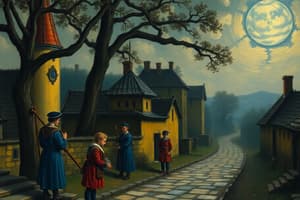Podcast
Questions and Answers
In 1500, which social class was most likely to control significant landholdings?
In 1500, which social class was most likely to control significant landholdings?
The decline of the Mongol Empire in the 16th century had a major impact on:
The decline of the Mongol Empire in the 16th century had a major impact on:
What was a primary source of conflict between European monarchs and their nobility in the 16th century?
What was a primary source of conflict between European monarchs and their nobility in the 16th century?
Which of these groups held a position of significant wealth and influence in 16th-century European society?
Which of these groups held a position of significant wealth and influence in 16th-century European society?
Signup and view all the answers
What was a key characteristic of the Columbian Exchange?
What was a key characteristic of the Columbian Exchange?
Signup and view all the answers
Why did European exploration for new trade routes intensify in the 16th century?
Why did European exploration for new trade routes intensify in the 16th century?
Signup and view all the answers
What was a primary characteristic of feudal society in Medieval Europe?
What was a primary characteristic of feudal society in Medieval Europe?
Signup and view all the answers
Which of the following statements accurately describes the role of the Church in medieval Europe?
Which of the following statements accurately describes the role of the Church in medieval Europe?
Signup and view all the answers
Study Notes
The World in 1500
- Europe in 1500 comprised many competitive states, many of which still exist today, although borders and compositions have changed
- European political and religious leaders sought to expand their power within their borders, creating a hierarchical society.
- Monarchs were the most powerful, ruling over nobles who also acted as a check on their power. Nobles owned land and wealth and often served the monarch.
- Below the nobility were merchants, craftsmen, and artisans, some quite wealthy
- Peasants formed the lowest social class, working the land of nobles and often having limited freedom.
- The Church (Catholic) held significant power and influence, rivaling that of monarchs.
Feudal Society in Medieval Europe
- Medieval Europe's social structure was stratified and unstable, often leading to disunity
- The hierarchical social classes fostered issues and disagreements
Europe in the 1500s
- Old institutions were being replaced by new structures, including religious and political entities
- The Mongol Empire declined, and the Ottoman Empire emerged as a dominant force.
- The decline of the Mongol Empire and rise of the Ottoman Empire significantly altered human history.
- The Ottomans disrupted the profitable spice trade routes of Asia
- Europeans sought new maritime exploration routes to Asia.
- Christopher Columbus's voyage across the Atlantic Ocean in 1492 initiated the Columbian Exchange.
- The Columbian Exchange involved the exchange of people, diseases, plants, goods, and ideas between the Americas, Africa, Asia, and Europe.
Studying That Suits You
Use AI to generate personalized quizzes and flashcards to suit your learning preferences.
Related Documents
Description
Explore the intricacies of Europe's social hierarchy in 1500, where monarchs, nobles, and peasants interacted within a stratified society. This quiz delves into the political and religious influences that shaped the continent during this pivotal time. Test your knowledge of feudal society and the significant role of the Church in Europe’s power dynamics.



